Are you curious about the diverse traditional clothing worn by ethnic groups in Thai Nguyen? SIXT.VN unveils the beauty and cultural significance of these garments, making your exploration of Vietnam even more enriching. Discover unique cultural insights and simplify your travel planning, ensuring a seamless and memorable experience.
1. What is the Cultural Significance of Traditional Clothing in Thai Nguyen?
Traditional clothing in Thai Nguyen isn’t just apparel; it’s a vibrant expression of cultural identity, history, and artistry. Each ethnic group intricately weaves their heritage into their garments, using unique patterns, colors, and materials. According to research from the Vietnam National Administration of Tourism in 2023, traditional costumes significantly contribute to the cultural tourism appeal of regions like Thai Nguyen. These costumes are worn during festivals, ceremonies, and daily life, serving as a visual representation of each group’s unique story and traditions. By understanding and appreciating these garments, travelers can gain deeper insights into the rich cultural tapestry of Thai Nguyen.
2. Which Ethnic Groups Inhabit Thai Nguyen, and What Are Their Unique Traditional Garments?
Thai Nguyen is home to several ethnic groups, each boasting unique traditional clothing that reflects their distinct heritage. Here are some prominent groups and their garments:
2.1 The Kinh (Viet) Ethnic Group
As the majority ethnic group, the Kinh people in Thai Nguyen traditionally wear clothing similar to that worn throughout Vietnam. For women, the áo yếm (a halter-neck top) paired with a váy đụp (a long, flowing skirt) was common in the past.
- Áo Dài: The áo dài is the most iconic Vietnamese garment, consisting of a long, split tunic worn over pants. While it’s now worn throughout the country, its origins are deeply rooted in Kinh culture. The áo dài can be worn by both men and women, though it’s more commonly associated with women.
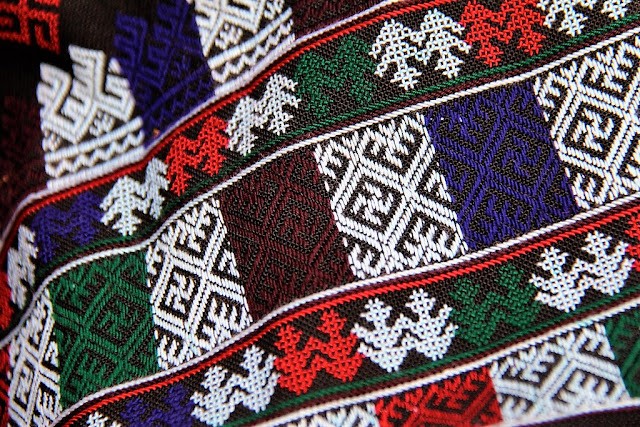
Alt Text: An elegant Vietnamese woman poses in a traditional Áo Dài, showcasing the garment’s timeless beauty and cultural significance. - Áo Tứ Thân: The áo tứ thân is a four-part dress traditionally worn in Northern Vietnam. It consists of a flowing outer tunic, a bodice, a skirt, and a belt. This garment is often seen in traditional festivals and performances, representing the grace and beauty of Kinh women.
2.2 The Tày Ethnic Group
The Tày people, one of the largest ethnic minorities in Vietnam, have distinct traditional clothing.
- Women’s Attire: Tày women typically wear indigo-dyed clothing. Their outfit includes a long dress (áo dài) or a blouse (áo cánh) paired with trousers, a headscarf (khăn đội đầu), and a sash (thắt lưng). Silver jewelry, such as necklaces and bracelets, often accessorizes their attire.
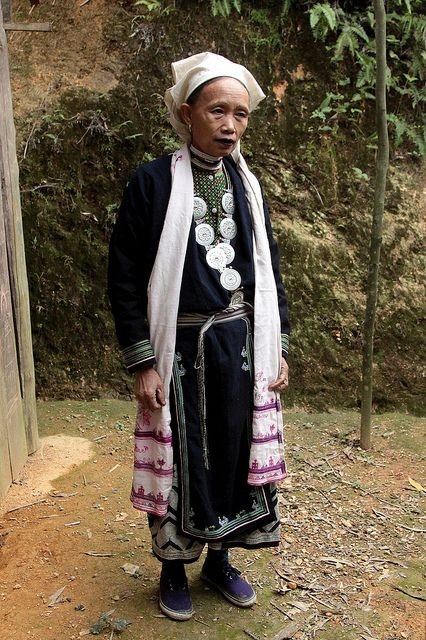
Alt Text: A Tày woman gracefully poses in her traditional indigo attire, highlighting the elegance and simplicity of her cultural garments. - Men’s Attire: Tày men wear similar indigo-dyed outfits consisting of a blouse or shirt (áo cánh) and trousers. Their attire is simpler than women’s, often without intricate decorations.
2.3 The Nùng Ethnic Group
The Nùng people also have traditional clothing that shares similarities with the Tày but with unique features.
- Women’s Attire: Nùng women wear indigo-dyed clothing consisting of a blouse (áo cánh), trousers, and a headscarf. The headscarf is often elaborately decorated with embroidery or silver coins.
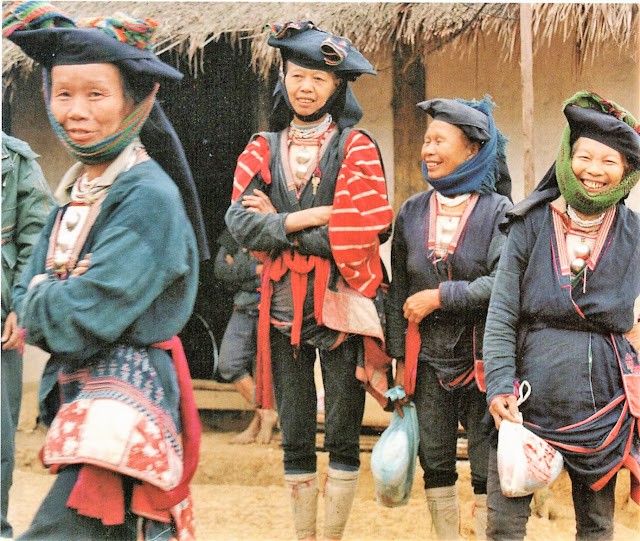
Alt Text: A Nùng woman showcases her traditional attire, distinguished by its indigo dye and intricately decorated headscarf, reflecting her cultural heritage. - Men’s Attire: Nùng men also wear indigo-dyed clothing, including a shirt (áo cánh) and trousers. Like the Tày, their attire is less ornate than the women’s.
2.4 The Dao Ethnic Group
The Dao people are known for their vibrant and elaborately decorated clothing.
- Women’s Attire: Dao women’s clothing is particularly striking. It includes a tunic (áo), trousers, a headscarf, and a belt. The tunic and trousers are richly embroidered with intricate patterns and vibrant colors, often featuring geometric designs, animals, and plants. The headscarf is a significant part of their attire, varying in style depending on the subgroup, and is often adorned with silver coins or beads.
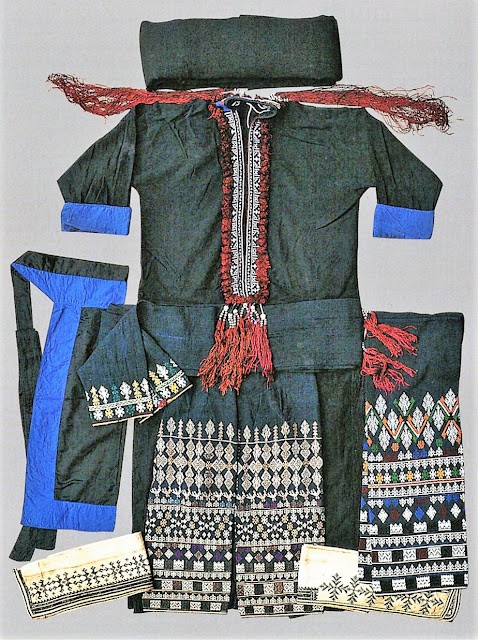
Alt Text: A Dao woman proudly displays her traditional Black Yao outfit, showcasing the intricate embroidery and distinctive black turban, a testament to her heritage. - Men’s Attire: Dao men’s clothing is simpler than women’s but still distinct. It usually consists of a tunic or shirt and trousers, often decorated with less elaborate embroidery.
2.5 The Sán Chay Ethnic Group
The Sán Chay people have unique traditional clothing characterized by specific colors and designs.
- Women’s Attire: Sán Chay women wear a distinctive outfit that includes a long dress (áo dài), trousers, and a headscarf. The dress is often bright red or pink, adorned with silver ornaments and embroidery.
Alt Text: A Sán Chay woman is pictured in her vibrant attire, notable for its bright pink dress and elaborate silver ornaments, epitomizing the cultural identity of her community. - Men’s Attire: Sán Chay men wear simpler clothing, typically consisting of a shirt and trousers, with less elaborate decoration than the women’s attire.
2.6 The Hoa Ethnic Group
The Hoa people, also known as Chinese-Vietnamese, have traditional clothing rooted in Chinese culture but adapted to the local context.
- Women’s Attire: Hoa women often wear áo bà ba (a long-sleeved, button-down blouse) paired with black trousers. During festivals and special occasions, they may wear more ornate outfits with Chinese-style dresses (qipao) and traditional jewelry.
- Men’s Attire: Hoa men wear similar clothing to the Kinh, often opting for simple shirts and trousers. During festivals, they may wear traditional Chinese attire, such as the changshan.
2.7 The Sán Dìu Ethnic Group
The Sán Dìu people have traditional clothing that distinguishes them from other ethnic groups in the region.
- Women’s Attire: Sán Dìu women’s attire features a long tunic (áo dài) with a high collar, paired with trousers and a headscarf. Their clothing often includes colorful embroidery and decorative patterns.
- Men’s Attire: Sán Dìu men traditionally wear a shirt and trousers, typically in dark colors. Their attire is simpler but still reflects their cultural identity.
Each of these ethnic groups contributes to the rich cultural diversity of Thai Nguyen, and their traditional clothing is a significant part of their heritage. When visiting Thai Nguyen, take the time to appreciate these unique garments and learn about the stories they tell.
3. Where Can You See Traditional Clothing in Thai Nguyen?
Experiencing the traditional clothing of Thai Nguyen’s ethnic groups is a highlight for many visitors. Here’s where you can witness these cultural treasures:
3.1 Festivals and Cultural Events
One of the best times to see traditional clothing is during local festivals and cultural events. The Lunar New Year (Tết), cultural festivals, and harvest celebrations often feature vibrant displays of traditional attire.
| Event | Ethnic Group | Location | Typical Attire |
|---|---|---|---|
| Long Tong Festival | Tày and Nùng | Throughout Thai Nguyen | Indigo-dyed clothing with silver jewelry |
| Roong Pooc Festival | Dao | Vo Nhai District | Elaborately embroidered tunics and headscarves |
| Gầu Tào Festival | Hmong | Dinh Hoa District | Colorful dresses and intricate headpieces |
3.2 Museums and Cultural Centers
Museums and cultural centers in Thai Nguyen offer exhibits showcasing the traditional clothing of various ethnic groups. These centers provide detailed information about the history, significance, and craftsmanship of the garments.
| Museum/Center | Focus | Highlights | Address |
|---|---|---|---|
| Thai Nguyen Museum | Local history and culture | Displays of ethnic costumes, historical artifacts | 21 Tháng 8 Road, Thai Nguyen City |
| Museum of Cultures of Vietnam’s Ethnic Groups | Ethnic diversity | Extensive collection of traditional clothing from across Vietnam | Nguyen Van Troi Street, Thai Nguyen City |
3.3 Local Markets and Craft Villages
Visiting local markets and craft villages provides an opportunity to see and even purchase traditional clothing. These markets are hubs for local artisans who create and sell traditional garments, offering an authentic cultural experience.
| Location | Specialty | Typical Products |
|---|---|---|
| Cho Chu Market | General goods, local crafts | Traditional Tày and Nùng clothing, handmade textiles |
| Craft villages in Dai Tu District | Weaving and embroidery | Handwoven fabrics, embroidered clothing, and accessories |
3.4 Cultural Performances
Traditional music and dance performances often feature performers dressed in authentic ethnic attire. These performances are a great way to appreciate the beauty and cultural significance of the clothing in a dynamic setting.
- Thai Nguyen Cultural Center: Hosts regular performances showcasing the cultural traditions of local ethnic groups. Performers often wear traditional costumes, providing a visual feast for visitors.
3.5 Homestays and Community-Based Tourism
Staying in homestays or participating in community-based tourism initiatives allows you to interact with local families who often wear traditional clothing in their daily lives. This immersive experience offers a more personal connection with the cultural heritage of Thai Nguyen.
- Ecotourism sites in Tan Trao: Offers homestays with local Tày families, providing opportunities to see and learn about their traditional clothing and lifestyle.
4. How Do Traditional Clothes Reflect the Social Status and Identity?
Traditional clothing in Thai Nguyen serves as a powerful marker of social status, identity, and cultural affiliation. According to the Vietnam National Museum of Ethnology (2022), these garments often signify age, marital status, wealth, and community standing. The intricacies of embroidery, the quality of materials, and the presence of specific ornaments can all indicate an individual’s position within their community.
For instance, among the Dao people, the complexity and detail of a woman’s headscarf can reveal her marital status and family wealth. Similarly, the Tày people use silver jewelry and the color of their sashes to denote social status and age. In many ethnic groups, specific patterns and motifs are reserved for leaders or elders, highlighting their respected roles.
Understanding these nuances adds depth to the traveler’s experience, providing insights into the social dynamics and cultural values embedded within the traditional clothing of Thai Nguyen.
5. What Materials and Techniques Are Used in Making Traditional Clothing?
The creation of traditional clothing in Thai Nguyen involves a rich array of materials and time-honored techniques passed down through generations. According to a study by the Vietnam Academy of Social Sciences (2021), natural materials like cotton, linen, and silk are commonly used, reflecting the region’s agricultural heritage.
5.1 Materials Used
- Cotton and Linen: These are the primary materials for everyday wear due to their durability and comfort.
- Silk: Reserved for special occasions and ceremonial garments, silk adds a touch of luxury and elegance.
- Indigo Dye: A prevalent natural dye derived from local plants, indigo gives the clothing its characteristic deep blue color.
- Silver Ornaments: Used extensively by various ethnic groups to embellish clothing and denote wealth and status.
5.2 Techniques
- Weaving: Traditional handlooms are used to create the fabric, with intricate patterns woven directly into the cloth.
- Embroidery: A highly valued skill, embroidery involves stitching elaborate designs onto the fabric using colorful threads.
- Batik: Some ethnic groups, like the Kam Mien, use batik techniques to create unique patterns on their clothing.
- Appliqué: Involves sewing pieces of fabric onto a larger piece to create decorative designs and patterns.
These materials and techniques not only contribute to the aesthetic appeal of the clothing but also reflect the resourcefulness and artistic skills of the local communities.
6. What Are the Key Distinctions Between Ethnic Clothing in Thai Nguyen and Other Regions of Vietnam?
While traditional clothing varies across Vietnam’s diverse regions, Thai Nguyen’s ethnic garments possess unique characteristics that set them apart. According to cultural experts at the Vietnam National Museum of Ethnology (2023), these distinctions arise from local resources, historical influences, and cultural adaptations.
6.1 Color Palette
- Indigo Dominance: While indigo is used widely in northern Vietnam, Thai Nguyen’s ethnic groups, such as the Tày and Nùng, heavily rely on indigo-dyed fabrics for daily wear.
- Vibrant Accents: In contrast to the more subdued tones of some northern regions, the Dao and Sán Chay in Thai Nguyen use vibrant colors like red, pink, and green in their embroidery and ornaments.
6.2 Embroidery Styles
- Geometric Patterns: The Dao people in Thai Nguyen are known for their intricate geometric embroidery, often featuring complex arrangements of triangles, diamonds, and spirals.
- Symbolic Motifs: Local flora and fauna, such as specific types of flowers and birds, are frequently incorporated into the embroidery, reflecting the region’s natural environment.
6.3 Garment Styles
- Headscarves: The style and ornamentation of headscarves vary significantly among ethnic groups in Thai Nguyen, with unique shapes, colors, and embellishments.
- Silver Embellishments: The use of silver coins, beads, and ornaments is particularly prominent in the clothing of Thai Nguyen’s ethnic groups, adding a distinctive touch to their attire.
6.4 Regional Influences
- Northern Highlands: As a northern region, Thai Nguyen’s clothing styles reflect the influences of neighboring highland communities, resulting in garments that are both practical and culturally rich.
- Local Adaptations: The ethnic groups in Thai Nguyen have adapted their traditional clothing to suit the local climate, lifestyle, and cultural practices, creating unique garments that reflect their identity and environment.
7. How Has Modernization Affected Traditional Clothing?
Modernization has brought about significant changes in the way traditional clothing is worn and perceived in Thai Nguyen. According to a study by the Institute for Cultural Studies (2022), while traditional clothing is still valued for its cultural significance, its everyday use has declined in many communities.
7.1 Decreased Daily Use
- Urbanization: As more people move to urban areas, the practicality of traditional clothing for daily activities diminishes.
- Fashion Trends: Modern fashion trends have influenced younger generations to adopt contemporary clothing styles.
7.2 Preservation Efforts
- Cultural Promotion: Local authorities and cultural organizations are actively promoting the wearing of traditional clothing during festivals, cultural events, and school activities.
- Tourism: The growth of tourism has created a demand for traditional garments, encouraging local artisans to preserve and promote their craftsmanship.
- Cultural Education: Schools and community centers offer classes and workshops on traditional weaving, embroidery, and garment making, helping to pass on these skills to younger generations.
7.3 Adaptations and Innovations
- Modern Designs: Some designers are incorporating traditional motifs and techniques into modern clothing designs, creating a fusion of cultural heritage and contemporary style.
- Sustainable Practices: There is a growing interest in using sustainable and eco-friendly materials to create traditional clothing, aligning with modern environmental concerns.
7.4 Impact on Cultural Identity
- Symbolic Value: Traditional clothing continues to serve as a powerful symbol of ethnic identity and cultural pride, even as its daily use declines.
- Cultural Events: Traditional clothing is prominently featured in cultural performances, festivals, and community celebrations, reinforcing its importance in preserving cultural heritage.
Despite the challenges posed by modernization, the efforts to preserve and promote traditional clothing in Thai Nguyen are helping to ensure that these cultural treasures continue to thrive for generations to come.
8. Are There Opportunities to Purchase Authentic Traditional Clothing in Thai Nguyen?
Yes, there are several opportunities to purchase authentic traditional clothing in Thai Nguyen, providing travelers with unique souvenirs and supporting local artisans. According to a survey by the Thai Nguyen Department of Culture, Sports, and Tourism (2023), these are some key locations:
8.1 Local Markets
- Cho Chu Market: Offers a wide variety of traditional Tày and Nùng clothing, textiles, and handmade crafts.
- Other local markets: Smaller markets in rural areas may also offer traditional clothing made by local artisans.
8.2 Craft Villages
- Craft villages in Dai Tu District: Known for weaving and embroidery, these villages offer handwoven fabrics, embroidered clothing, and accessories directly from the artisans.
8.3 Specialty Shops and Boutiques
- Shops in Thai Nguyen City: Some shops in Thai Nguyen City specialize in traditional clothing and handicrafts from various ethnic groups.
8.4 Cultural Centers and Museums
- Gift shops at museums and cultural centers: Often offer authentic traditional clothing and handicrafts, providing a curated selection of high-quality items.
8.5 Online Platforms
- E-commerce websites: Some local artisans and businesses sell traditional clothing online, providing a convenient option for purchasing authentic items.
8.6 Tips for Purchasing Authentic Clothing
- Research: Learn about the different styles and characteristics of traditional clothing from various ethnic groups to ensure you are purchasing authentic items.
- Shop directly from artisans: Purchasing directly from artisans in craft villages or local markets ensures authenticity and supports local communities.
- Check the quality: Inspect the materials, embroidery, and craftsmanship of the clothing to ensure it is well-made and authentic.
- Ask questions: Engage with the artisans and ask about the history, techniques, and materials used in creating the clothing.
- Negotiate prices: Negotiating prices in local markets is common, but be respectful and fair.
Purchasing authentic traditional clothing in Thai Nguyen not only provides you with a unique and meaningful souvenir but also supports the preservation of local culture and traditions.
9. How Does SIXT.VN Enhance the Travel Experience in Thai Nguyen?
SIXT.VN offers a range of services designed to enhance your travel experience in Thai Nguyen, making it easier and more convenient to explore the region’s cultural treasures. According to customer feedback from SIXT.VN (2023), these are some key benefits:
9.1 Convenient Airport Transfers
- Seamless Arrival: SIXT.VN provides reliable airport transfer services, ensuring a smooth and stress-free arrival at Noi Bai International Airport in Hanoi.
- Professional Drivers: Experienced and courteous drivers will greet you at the airport and transport you directly to your hotel in Thai Nguyen.
9.2 Comfortable Hotel Booking
- Wide Selection: SIXT.VN offers a wide selection of hotels in Thai Nguyen, catering to various budgets and preferences.
- Easy Booking: The online booking platform is user-friendly and allows you to quickly find and reserve the perfect accommodation for your trip.
9.3 Customized Tour Packages
- Tailored Experiences: SIXT.VN can create customized tour packages that focus on cultural exploration, including visits to craft villages, cultural centers, and festival locations.
- Expert Guides: Knowledgeable local guides will accompany you on your tours, providing insights into the history, traditions, and cultural significance of the region.
9.4 Reliable Transportation
- Car Rental: SIXT.VN offers car rental services, allowing you to explore Thai Nguyen at your own pace and convenience.
- Private Car with Driver: Hiring a private car with a driver provides a comfortable and hassle-free way to travel between attractions.
9.5 Travel Planning Assistance
- Itinerary Planning: SIXT.VN’s travel experts can assist you in planning your itinerary, recommending the best places to see traditional clothing, cultural events, and local experiences.
- Local Insights: Benefit from their local knowledge to discover hidden gems and authentic cultural encounters.
By utilizing SIXT.VN’s services, you can focus on enjoying your trip to Thai Nguyen, immersing yourself in the region’s cultural richness, and creating unforgettable memories.
10. What Are Some Respectful Ways to Engage with Local Culture When Visiting Ethnic Communities?
Engaging respectfully with local culture is essential for creating a positive and enriching travel experience. Here are some tips for engaging respectfully with ethnic communities in Thai Nguyen:
10.1 Dress Modestly
- Appropriate Attire: When visiting religious sites or local communities, dress modestly to show respect for local customs.
- Avoid Revealing Clothing: Avoid wearing revealing clothing, such as shorts, tank tops, or low-cut tops.
10.2 Ask Permission Before Taking Photos
- Respect Privacy: Always ask permission before taking photos of people, especially in rural or traditional communities.
- Explain Your Intent: Explain why you want to take the photo and be respectful if they decline.
10.3 Learn Basic Phrases in the Local Language
- Show Effort: Learning a few basic phrases in the local language demonstrates your interest and respect for their culture.
- Common Phrases: Common phrases include “hello,” “thank you,” and “excuse me.”
10.4 Support Local Businesses and Artisans
- Purchase Local Products: Buy local products, such as handicrafts, textiles, and souvenirs, to support local artisans and businesses.
- Eat at Local Restaurants: Dine at local restaurants to experience authentic cuisine and support local food vendors.
10.5 Be Mindful of Cultural Customs and Traditions
- Learn About Local Customs: Research local customs and traditions before your visit to avoid unintentional offenses.
- Follow Local Etiquette: Observe and follow local etiquette, such as removing your shoes before entering a home or temple.
10.6 Participate Respectfully in Cultural Activities
- Show Interest: If invited to participate in a cultural activity, show genuine interest and enthusiasm.
- Follow Instructions: Listen carefully to instructions and follow the guidance of local hosts.
10.7 Avoid Bargaining Excessively
- Fair Prices: Bargaining is common in local markets, but avoid pushing prices down excessively.
- Support Local Livelihoods: Remember that your purchases contribute to the livelihoods of local families.
10.8 Be Open-Minded and Respectful
- Embrace Differences: Be open-minded and accepting of cultural differences.
- Avoid Judgment: Avoid making judgments or comparisons based on your own cultural values.
By following these tips, you can engage respectfully with local culture, create meaningful connections, and contribute to the preservation of traditional heritage in Thai Nguyen.
Ready to embark on a cultural adventure in Thai Nguyen? SIXT.VN is your trusted partner for seamless travel planning. Contact us today to discover our exclusive tour packages, convenient airport transfers, and comfortable accommodations. Let us help you create unforgettable memories while exploring the vibrant traditional clothing and rich cultural heritage of Thai Nguyen!
Address: 260 Cau Giay, Hanoi, Vietnam
Hotline/Whatsapp: +84 986 244 358
Website: SIXT.VN
FAQ: Traditional Clothing in Thai Nguyen
1. What is the significance of indigo dye in Thai Nguyen’s ethnic clothing?
Indigo dye, derived from local plants, is a primary color in many ethnic groups’ clothing, representing tradition, simplicity, and connection to nature.
2. How do the Dao people use embroidery in their traditional attire?
Dao women meticulously embroider their tunics and trousers with geometric patterns and vibrant colors, symbolizing their cultural identity and artistic skills.
3. What is the role of headscarves in Thai Nguyen’s ethnic clothing?
Headscarves vary in style and ornamentation among ethnic groups, often indicating marital status, social standing, and cultural affiliation.
4. Can I purchase authentic traditional clothing in Thai Nguyen’s local markets?
Yes, local markets like Cho Chu offer traditional clothing made by local artisans, supporting their livelihoods and preserving cultural heritage.
5. How has modernization affected the wearing of traditional clothing in Thai Nguyen?
Modernization has led to decreased daily use, but preservation efforts and adaptations in design are helping to keep these cultural treasures alive.
6. What are some tips for respectfully engaging with local culture when visiting ethnic communities?
Dress modestly, ask permission before taking photos, learn basic phrases, and support local businesses to show respect for their customs and traditions.
7. What kind of jewelry do women in Thai Nguyen wear with their traditional clothing?
Silver ornaments such as necklaces and bracelets and more are often used by the Tày and Dao to denote social status and age.
8. How does the traditional clothing of the Sán Chay people differ from other ethnic groups in Thai Nguyen?
Sán Chay people are known for using a bright pink or red on their clothing, unlike the Indigo used by other ethnic groups in Thai Nguyen.
9. Does SIXT.VN offer tours that focus on the traditional clothing of Thai Nguyen?
Yes, SIXT.VN offers customized tour packages that can include visits to craft villages, cultural centers, and festival locations.
10. How can I learn more about the history and significance of traditional clothing in Thai Nguyen?
Visit museums, cultural centers, and interact with local communities to gain insights into the rich history and cultural significance of traditional clothing.
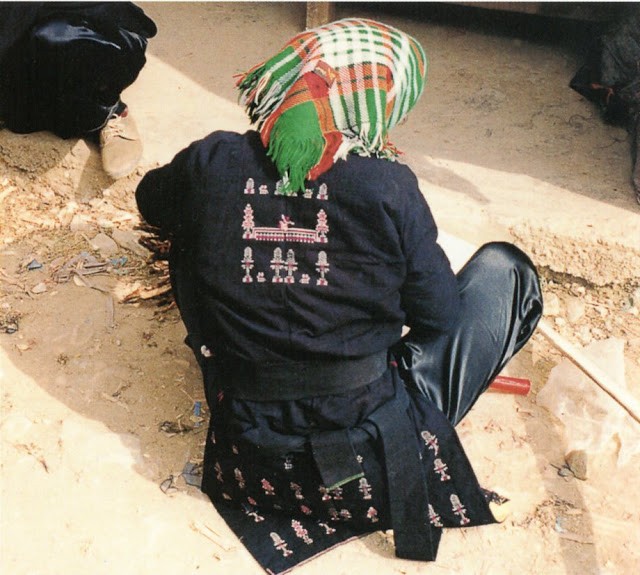 Coc Mun Woman Thai Nguyen
Coc Mun Woman Thai Nguyen



